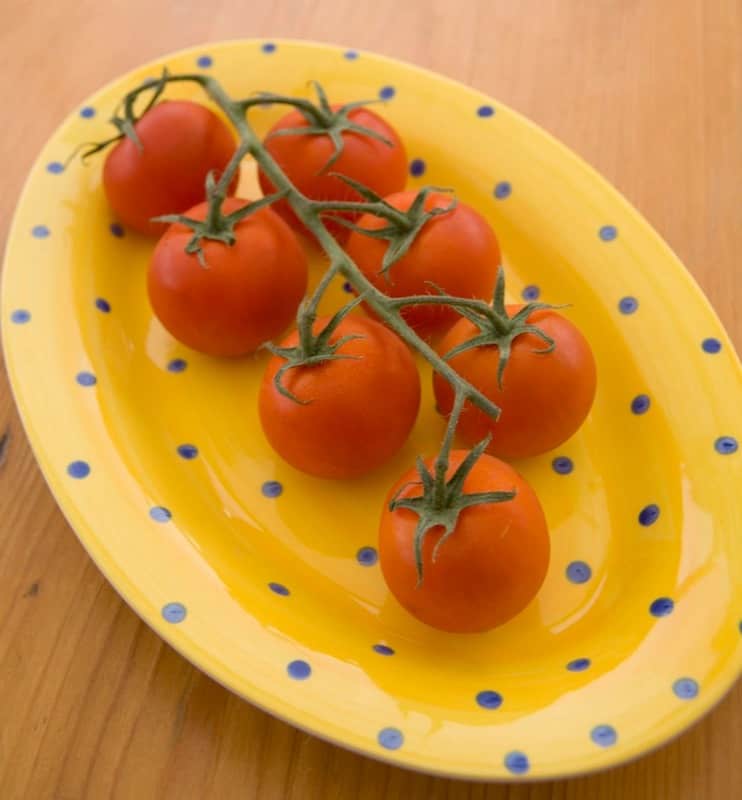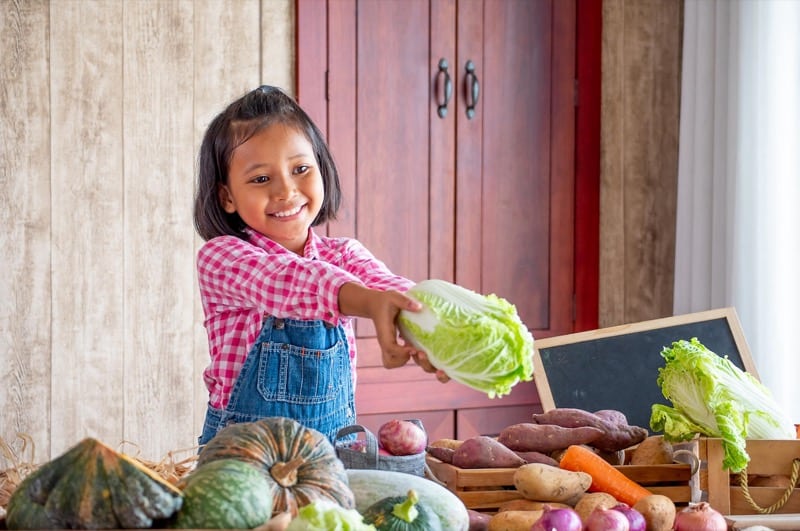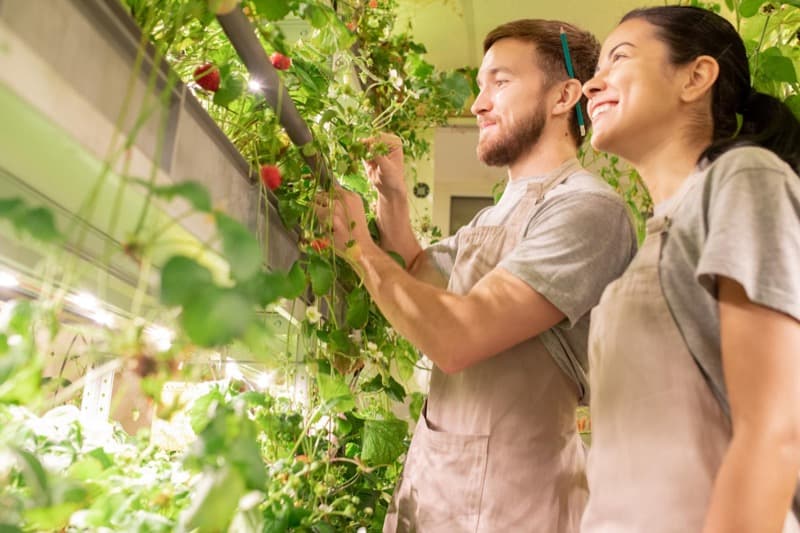Growing vegetables indoors is fun, cheap, and easy. But most people who try it fail because they don’t understand how to do it correctly. Maintaining a vegetable garden doesn’t require an experienced green thumb.
Growing vegetables indoors is great for beginners, but it’s not as simple as just throwing seeds in dirt and watering them every day. There are many factors involved with growing vegetables indoors, and you need to understand each one before moving on to the next for successful, edible vegetables.
This article will cover everything you need to know about growing vegetables indoors. From choosing the right plants to lighting, soil, and water, I’ll cover everything you need to know for a healthy indoor vegetable garden.
I’ll also share my top tips for growing vegetables indoors, including which plants work best, how to choose the right pots, and how to make sure your plants get enough light.
Can You Grow Vegetables Indoors Year Round?
Most of us are restricted to growing most of our fruit and vegetables during the warm summer months. Although there are a few crops that can grow in winter, even the most well-maintained garden will be less productive during the winter.
How about growing crops indoors? Is it possible to grow summer vegetables all year? Well, the answer is yes, but with some provisions.
While your home will stay warm all year round, plants don’t just need warmth to grow. The lifecycle of most plants is dictated by the amount of sunlight, as well as the temperature. Vegetables know when to blossom, fruit, and seed by the length of the day, as well as the heat.
Most summer vegetables need at least fourteen hours of sunlight to grow. You may be wondering if the lights in your house provide a sufficient source of light. Unfortunately, regular bulbs don’t produce the same spectrum of light as the sun.
The good news is that if you are determined to grow summer vegetables in the winter, special LED grow lights have been developed for this purpose. You can now get LED lamps that don’t take up much space and are perfect for growing veggies all year round.
Learn more about How Much Sunlight Vegetable Gardens Need.
Best Vegetables to Grow Indoors for Beginners
The good news is that any vegetable can be grown indoors. There are many easy vegetables to grow. Your only limitation is living space.
Below I’ve listed seven popular vegetables you might want to try growing indoors if you’re a beginner.
1. Salad Greens and Leaves
Salad leaves and lettuce plants are the best vegetables for a kitchen garden as many varieties allow leaves to be continually harvested from the plant. They can be grown in a compact area, and they grow relatively quickly.
Most salad leaves need around 12 hours of sunlight a day, and they like temperatures of about 60 degrees Fahrenheit.
Salad leaves may wilt or bolt if they get too hot, so keep an eye on them if they are on a windowsill in the summer. But you will still need to employ artificial lighting and grow lights in the winter months for plant light source.
2. Chili
Chilies are a great plant to grow indoors because they can look fantastic as houseplants, as well as provide you with delicious spicy treats.
Different varieties grow to different sizes, so pick one that fits your available indoor space. As chilies need a long growing season, they are perfect for growing indoors, and their colorful flowers and fruits will brighten up your kitchen.
Chili plants need around 8-12 hours of sunlight per day. Chilies need temperatures of 80-90°F to germinate.
3. Radish
Radishes are super quick to grow, only taking around a month from germination to harvest. For this reason, they are great to grow indoors.
Plant a row of seeds every week or two for successive harvests. Radishes don’t like to be crowded and won’t form bulbs if they don’t have enough room.
Radishes prefer temperatures around 40-70°F. They only need 6 hours of direct sunlight in the summer, but they still need 12 hours of daylight to grow.
4. Tomatoes

Tomatoes like a lot of sun, heat, and a long growing season, so they are great for growing indoors. If you are short on space, mini-tomato varieties are available that only get up to 8 inches tall.
Fresh tomatoes are so delicious, they are definitely worth trying to grow all year round. When it comes to indoor vegetable gardening, these are popular fresh vegetables to grow.
Tomatoes need around 8 hours in the full sun and 12-16 hours of light to grow.
5. Garlic
Garlic is a perfect plant to begin with. You may even already have a sprouting garlic clove in your kitchen cupboard.
Garlic doesn’t need a large pot to grow, and you can harvest the leaves rather than try and get a bulb to form.
6. Scallion
Scallions are super easy to grow indoors and will tolerate low to moderate light conditions. You don’t need a green thumb to grow scallions.
They can be grown from scraps, and you can harvest the green tops multiple times. They don’t take up much space and are a great garnish for a wide variety of dishes.
7. Herbs
Some people may question whether herbs count as a vegetable, but technically, they are similar to leafy greens. However you classify them, herbs are a great way to start growing fresh produce indoors.
Popular herbs to grow indoors include basil, cilantro, parsley, rosemary, sage, thyme, and oregano. They are the usual staples of an indoor herb garden, especially for compact spaces.
You can harvest small amounts of herb leaves as they grow, and they will stay productive as long as you look after them.
To grow herbs all year, you will need to provide them with around 12 hours of light (depending on the herb). Herbs look and smell great and are ideal plants to grow indoors.
How to Start Growing Vegetables Indoors
Soil for Growing Vegetables Indoors
There are multiple soil and growing medium options for indoor vegetable growing. You can use high-quality organic potting soil, normal potting soil or a mix of soil and compost.
But compost and soil can contain contaminants like fly eggs and pathogens, so some indoor gardeners choose to use a soil-less growing medium.
Most vegetables will be fine in a soil-less potting mix too. However, you should keep in mind that these potting mixes will not contain any nutrients, so you will need to use fertilizer to help your plants grow.
Choose fertilizers that have the right blend of nutrients for your plant and research at what stage they will need an extra boost of nutrients.
If you are growing in your kitchen, a soil-less mix will also be more hygienic than using soil and compost.
Learn more about Best Fertilizers for Vegetables and the Best Compost for Vegetable Gardens.
Light for Growing Vegetables Indoors
Light won’t be so much of an issue for your indoor veggies during the summer. Most will be fine on (or near) a sunny windowsill with plenty of sunlight. Or you can put your vegetable plants on the balcony during the day if you have one.
However, when the nights start drawing in (or if you don’t have the space to place them near a window), you will need to supplement their natural light with a grow light.
Grow lights come in many forms, from hanging lights to lamps, so finding one that suits your needs won’t be too hard. The great thing about LED grow lights is that they don’t get as hot as traditional lights and less likely to burn or overheat your plants.
Water for Growing Vegetables Indoors
Rainwater is always preferable when watering plants, as it doesn’t contain the same chemicals as tap water.
However, if you are unable to collect rainwater to use, let your tap water sit out for around 24 hours to allow the chlorine to dissipate before using it.
Give your plants a good soak once a week, rather than watering them a bit every day, especially if you have deep containers. Make sure your pots have proper drainage holes and always place potted plants on a saucer to allow excess water to drain out of the pot.
Temperature, Humidity and Climate for Growing Vegetables Indoors
The ideal temperature really does depend on the plant. Putting the plants near a sunny window will also help with giving them warmth.
In general, cool-season crops – like radishes, onions, chives, and chard – need a cooler temperature range of around 50-70°F.
Warm-season crops – like tomatoes and peppers – prefer warmer temperatures above 70°F.
Humidity levels shouldn’t be a problem for most vegetables, but it could be if you have your heating systems on during the winter. Heaters will dry the air.
You can invest in a humidifier for the plants or use a spray bottle to mist your plants with water regularly.
Air Circulation for Growing Vegetables Indoors
Air circulation is important for indoor vegetables. Airflow prevents condensation from building up on leaves and fruits, reducing the risk of fungus growth, fungal infections, and helps the plants grow stable limbs.
This factor is especially important for fruiting plants like tomatoes, as they will need to be strong enough to support the fruit.
An open window can provide adequate airflow, but using a fan on a low setting can also be beneficial and preferable when it is too cold outside to leave the window open.
Fertilizers for Growing Vegetables Indoors
Liquid fertilizers are the way to go when growing indoor vegetables. You can water them in easily and add them when needed.
While many commercially available liquid fertilizers are chemical-based, you still have a few options if you want to keep it organic. You can create your own organic fertilizer like banana peel water.
Compost tea or vermicompost tea contains valuable nutrients as well as microorganisms, and you can make great liquid fertilizer from steeping nettles and comfrey in water.
Learn more about Different Fertilizer Types.
Containers for Growing Veggies Indoors
Pots and containers come down to what you are growing and how you want it to look. You can get planters that are specially designed for windowsills or beautiful terracotta pots that will look amazing holding your chili or tomato plant.
You can utilize grow bags to grow potatoes, carrots, or peas if you have more room on your floor.
If you are growing on a shelf, then you will have to consider the weight of your pot plus the soil. In this case, choosing plastic pots and a soil-free potting mix will be the lightest option, allowing you to put more plants on the shelves.
Get Seeds for Indoor Vegetables
You can get seeds from most garden centers, but the best selection will be found online. Shopping online means you can easily find a seed packet variety that suits your space and needs.
Many vegetables that can be grown indoors, like tomatoes and peppers, are self-pollinating and you won’t need much help to produce fruit.
However, some rely on pollinators and will need your help. Hand pollinating is pretty simple, and you can even have a go at cross-pollination if you feel like creating your own special variety of vegetables!
If you grow open pollinated or heirloom varieties, you can also save plant seeds for future use. That saves you money from buying seeds every year.
Harvest Indoor Vegetables
Many indoor vegetables can be harvested as they grow, like salad leaves, garlic greens, chilies, and tomatoes. Harvesting your indoor plants will usually be easier than your outdoor garden ones.
Since it you will be checking the plants more regularly, you will be able to see when they are ready for harvesting.
With root crops like carrots and potatoes, you just need to empty the container and pick them out rather than digging them up.

When to Start an Indoor Vegetable Garden
If you are going all out and buying grow lights and heated propagators, you can start your indoor garden at any time.
If you want to try it out before you spend your hard-earned dollars on all the equipment, then start growing in the early spring to make the most of the natural daylight.
What Do I Need to Set Up an Indoor Vegetable Garden?
What you need depends on how much you are growing and how much you want to spend. Essentially, you just need a container, a growth medium (either potting mix or soil), and some plants.
Pot/Container – You can spend as much or as little as you like on the container, from the fanciest self-watering planter to a yogurt pot with some holes poked in the bottom.
Growing Medium – Your growth medium can be a soil-less potting mix or some soil and compost from your garden.
Seeds – You can grow from seed, buy seedlings, or use old sprouty potatoes or garlic cloves that you have in the kitchen.
It is perfectly possible to start an indoor vegetable garden without spending a dime. However, if you want to grow all year, you will want to invest in some proper containers and grow lights to keep your plants happy and healthy.
Challenges to Growing Vegetables Indoors
The biggest challenge you will face is probably giving your plants the right amount of light. You can get automatic timers for your grow lights to take the hassle out of it, but you will also want to use as much free natural light as possible.
As your plants will be in containers, watering is also an issue. If you go away, even for a few days, you may need to get someone to water your plant while you are away.
That being said, there are a few ways you can keep your plants watered, and there are plenty of self-watering systems that are available commercially as well as ones you can make at home.
Hydroponic Approach to Grow Vegetables Indoors

Setting up a hydroponic system is a great way to grow vegetables all year round. While this method is commonly associated with growing marijuana, it can be very successful for growing all sorts of edible crops.
Hydroponics is a soil-less gardening system that uses nutrient-rich water to grow plants. While it is low-maintenance, you will need electricity to run the lights and water pumps.
Using hydroponics can be a great space saver, as it makes it possible to grow plants vertically. This feature allows you to utilize wall space to pack in crops like lettuce and tomatoes, or fruits like strawberries.
There are also indoor smart garden systems like the AeroGarden systems that utilize hydroponic technology to grow herbs and vegetables indoors. Check out the options on their website.
Indoor Vegetable Garden Final Thoughts
Growing vegetables indoors is not difficult, but it does require planning ahead and careful attention to detail. It’s best to start small and build up slowly when starting out.
Choose beginner-friendly vegetable plants and then work your way to plants that need more care.
Indoor Vegetable Garden FAQs
What are the easiest vegetables to grow indoors?
Easy vegetables include tomatoes, hot peppers, cucumbers, lettuce, and herbs. Easy vegetables are usually small and can be planted directly into a container without any preparation. They are also sold already started and ready to go, so you don’t need to start from seeds.
What vegetables can grow indoors without sunlight?
Spinach and lettuce grow well indoors without sunlight, as do small plants. Plants that can withstand colder temperatures are also good choices. Tomatoes, peppers, and other plants that need to flower to grow fruit may have a harder time growing indoors.
How much light do indoor vegetables need?
Indoor vegetables need a lot of light. Generally, indoor veggies need 12 to 16 hours of sunlight each day. When indoors, most vegetable gardens are under artificial lights to get the needed sunlight. These grow lights can even be programmed to turn on and off automatically depending on the season.
What vegetables can I grow in pots?
All vegetables can grow in pots. Some vegetables grow better in large pots than smaller ones. Choose pots based on the vegetables you’re growing and how big your plants will get. You want to give them enough room to grow, but you don’t want them to become too crowded. Vegetables that do well in containers include leafy greens, root vegetables, and herbs.
What month do you start seeds indoors?
Generally, you want to start seeds indoors around late March or early April. That’s usually 6 to 8 weeks before the last frost date in your area. The timing will be perfect if you want to transplant the vegetables outdoors. If you don’t plan to transplant outside and will be continuing to grow vegetables indoors, then any month is a good time to start seeds.





